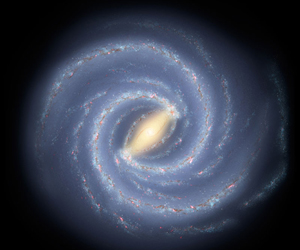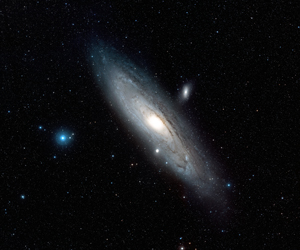Press Release: Weighing the Milky Way
International Team of Researchers, Including Carnegie Mellon's Matthew Walker, Devise Precise Method for Calculating the Mass of Galaxies
Contact: Jocelyn Duffy / 412-268-9982 / jhduffy@andrew.cmu.edu
 PITTSBURGH—Does the Milky Way look fat in this picture? Has Andromeda been taking skinny selfies? It turns out the way some astrophysicists have been studying our galaxy made it appear that the Milky Way might be more massive than its neighbor down the street, Andromeda.
PITTSBURGH—Does the Milky Way look fat in this picture? Has Andromeda been taking skinny selfies? It turns out the way some astrophysicists have been studying our galaxy made it appear that the Milky Way might be more massive than its neighbor down the street, Andromeda.
Not true, says a study published in the journal Monthly Notices of the Royal Astronomical Society by an international group of researchers, including Matthew Walker of Carnegie Mellon University's McWilliams Center for Cosmology. In the paper, they demonstrate a new, more accurate method for measuring the mass of galaxies. Using this method, the researchers have shown that the Milky Way has only about half the mass of its neighbor, the Andromeda Galaxy.
In previous studies, researchers were only able to estimate the mass of the Milky Way and Andromeda based on observations made using their smaller satellite dwarf galaxies. In the new study, researchers culled previously published data that contained information about the distances between the Milky Way, Andromeda and other close-by galaxies — including those that weren't satellites — that reside in and right outside an area referred to as the Local Group.
 Galaxies in the Local Group are bound together by their collective gravity. As a result, while most galaxies, including those on the outskirts of the Local Group, are moving farther apart due to expansion, the galaxies in the Local Group are moving closer together because of gravity. For the first time, researchers were able to combine the available information about gravity and expansion to complete precise calculations of the masses of both the Milky Way and Andromeda.
Galaxies in the Local Group are bound together by their collective gravity. As a result, while most galaxies, including those on the outskirts of the Local Group, are moving farther apart due to expansion, the galaxies in the Local Group are moving closer together because of gravity. For the first time, researchers were able to combine the available information about gravity and expansion to complete precise calculations of the masses of both the Milky Way and Andromeda.
"Historically, estimations of the Milky Way's mass have been all over the map," said Walker, an assistant professor of physics at Carnegie Mellon. "By studying two massive galaxies that are close to each other and the galaxies that surround them, we can take what we know about gravity and pair that with what we know about expansion to get an accurate account of the mass contained in each galaxy. This is the first time we've been able to measure these two things simultaneously."
By studying both the galaxies in and immediately outside the Local Group, Walker was able to pinpoint the group's center. The researchers then calculated the mass of both the ordinary, visible matter and the invisible dark matter throughout both galaxies based on each galaxy's present location within the Local Group. Andromeda had twice as much mass as the Milky Way, and in both galaxies 90 percent of the mass was made up of dark matter.
The study was supported by the UK's Science and Technology Facilities Council and led by Jorge Peñarrubia of the University of Edinburgh's School of Physics and Astronomy. Co-authors include Yin-Zhe Ma of the University of British Columbia and Alan McConnachie of the NRC Herzberg Institute of Astrophysics.
###
Using a new measurement technique, researchers have found that the Milky Way (artist rendition at top) has half the mass of the Andromeda Galaxy (image above).
Image Credits:
Andromeda image: ESA/Hubble & Digitized Sky Survey 2, Davide De Martin
Milky Way: NASA/JPL-Caltech